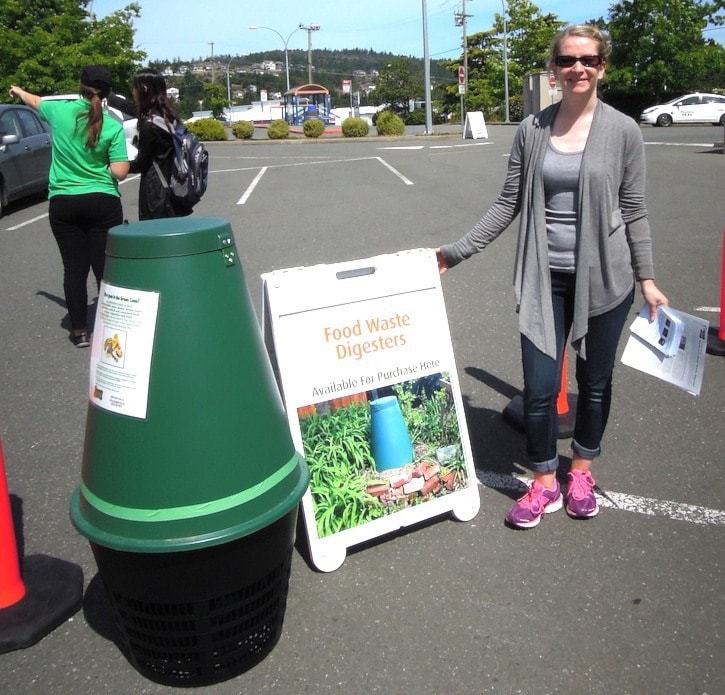Want to help the environment, lessen the burden on dump sites, enrich the soil in your garden, do less work than is required if you compost, all while reducing your garbage collection costs? The jolly Green Cone can help you do just that.
On June 15, the CRD sponsored a “Food Waste Digester Distribution Event” hosted by the Greater Victoria Compost Education Centre. Here, they educated people on the value of a food waste digester, which is kind of like a composter, only not really.
A composter you keep in the shade; a digester you put in the sun. A composter requires a blend of food and yard scraps; a digester consumes only food-related matter. A composter requires regular turning; a digester does not. A composter produces soil that can be turned into your garden; a digester produces water that seeps away unnoticed. And this last bit of information might help you decide where to place the Green Cone, as is outlined in the user manual, “nutrient rich water enters the soil under the base of the digestion unit.”
The food waste digester available at Saturday’s event is called the Green Cone. As described in their literature, this Green Cone digests food “and is primarily reduced to water. This nutrient rich water enters the soil under the base … and, unlike traditional composters, there is no need to manually turn the waste.”
In other words, after you install the Green Cone, you can add any kind of food scraps into it — fish, meat, bones, grains, dairy, fruit and vegetables, teabags and, even though it’s not exactly a food scrap although food produced it, you can even add in animal excrement.
Food scraps in the yard always raises questions about bear-proofing.
“Nothing is ever bear proof,” said Marika Smith, from the Compost Education Centre, “(but) the activity that is happening here is not appealing to them. … They are not attracted to it. … Because this (indicating the basket base of the container) is underground, the rodents, bears and racoons tend to just leave it alone.”
She can’t guarantee bears won’t come to it, but research and anecdotal evidence suggests wildlife tend not to bother with it.
An accompanying fact sheet says “it is important to establish the environment in the digester before adding large amounts of meat, bones and oily food scraps — generally 4-6 weeks.”
The unit itself is completely enclosed above ground, with a latch opening at the top. The base is buried underground.
Additional information on wild animal management can be found at the Green Cone’s website at www.greencone.ca/Intro/whatabout.php
According to the Capital Regional District’s website, “by January 1, 2015 kitchen scraps will be restricted from your garbage.” In response, collection agencies are gearing up to provide organic pick-up services. Alpine, for instance, begins it’s “soft introduction” of it’s organic pick-up program in various service areas earlier this year.
Other organizations are providing education. Even the District of Sooke is in on the act, giving advise on kitchen-scrap management on their website page, www.sooke.ca/EN/main/government/devservices/environment/waste_management.html
Once you remove organic matter from your household garbage, you both reduce it’s contents as well as reduce the smell. Which in turns means you might be able to reduce your curb-side pick-up service.
Wendy Dunn of CRD Environmental Resource Management said that the CRD is targeting sales to regions that have private residential collection services, and indicated Sooke is included in that group.
The Compost Education Centre is making them available for $130 each until the end of September, or while supplies last.
